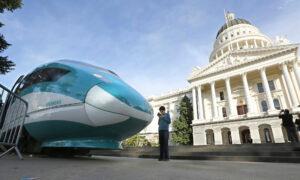California Governor Unveils Plans for First High-Speed Rail Track to Begin Construction Within Two Years
Officials estimate that passengers could start riding the high-speed trains as soon as 2030.
On January 6, California Governor Gavin Newsom was joined by local leaders from Kern County and representatives from the state’s High-Speed Rail Authority for the ceremonial installation of the first symbolic spikes in the long-anticipated high-speed train tracks.
“To achieve great things, we must aim for significant endeavors,” Newsom stated at the ceremony. “We represent the largest economy in the United States, and it’s about time we establish a high-speed rail system in California.”
He dismissed concerns raised by both political adversaries and project critics.
“To the skeptics who are content to stand by and criticize, we are here making this happen,” Newsom remarked. “We are finally at a stage where we will begin laying down track in the next few years.”
The gathering also acknowledged the completion of construction necessary to prepare the land for track installation on the southern segment, which will initially cover 171 miles from Merced to Bakersfield, and ultimately extend to 463 miles connecting Los Angeles to the Bay Area, in addition to interfacing with another planned project between Southern California and Las Vegas.
“Today we celebrate our system’s advancements and look forward as we establish vital partnerships and commence track work that will bring us closer to operations while providing employment for Californians,” stated Ian Choudri, CEO of the rail authority.
“We are dedicated to collaborating and ultimately creating a modern, interstate high-speed rail network that will not only enhance ridership in the Southwest region but also highlight the potential for delivering high-speed rail benefits sooner.”
The environmental assessments are finished, and construction for stations and track is imminent, with over 14,500 jobs created since the inception of this project, according to a statement from the governor’s office.
“Things are about to get very real,” Newsom asserted.
As projected, passengers could start using the high-speed trains by 2030.
Fresno Mayor Jerry Dyer stated that the rail system “provides a transformative opportunity for Fresno.”
“This project transcends mere transportation; it will connect our community to the wider state and stimulate economic development that will revitalize our downtown and beyond,” he expressed. “This initiative serves as a bridge between the Bay Area, Southern California, and our thriving Central Valley, creating new opportunities for residents and businesses alike.”
Critics highlight concerns over cost overruns and delays in construction, fearing that taxpayers will end up shouldering billions more than initially projected.
“We are running out of funds, and we have not even completed the valley segment, let alone the route from San Francisco to Los Angeles,” state Sen. Roger Niello told The Epoch Times. “We are uncertain about how to finance the completion of this project.”
“I would love to see high-speed rail in California, but it increasingly seems that we may not afford it,” Niello said.
The governor acknowledged the financial challenges yet remained hopeful.
“We have significantly financed this project,” Newsom stated. “Yes, there is a deficit, but it’s not one we cannot overcome.”
He expressed gratitude to President Joe Biden for the over $6 billion allocated by the federal government for the high-speed rail initiative and added that California is ready for the incoming administration of President-elect Donald Trump.
“Everyone understands the challenges we face, but we successfully navigated similar obstacles in the past, and I am confident we will continue to progress,” Newsom emphasized.
Some express skepticism regarding the future viability of the new rail system, pointing to the state’s own forecasts indicating that subsidies will likely be necessary to cover operational costs.
By 2030, if the section is complete, approximately 2.3 million trips are anticipated annually on the high-speed rail segment of the state’s rail system.
Officials aspire to increase the proportion of miles covered by passenger rail and transit in California from the current 2 percent to at least 20 percent by 2050, utilizing exclusively zero-emission trains.
If this target is met, approximately 200 million daily passenger miles would be shifted from highways to rail systems.





